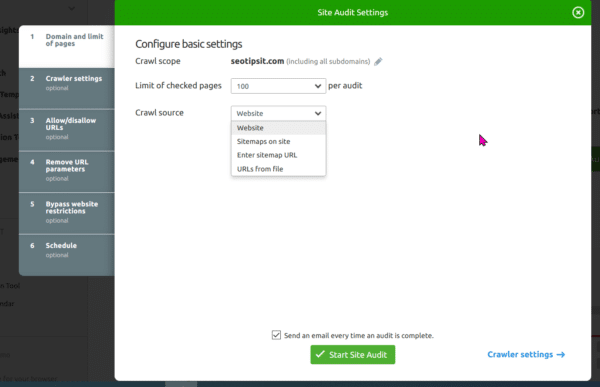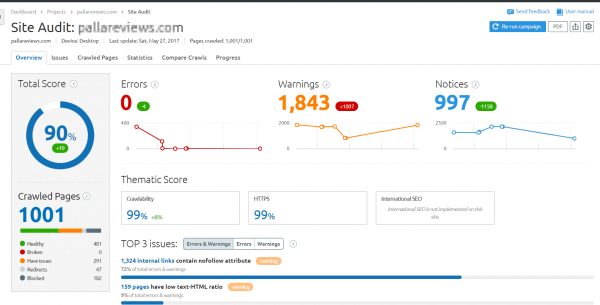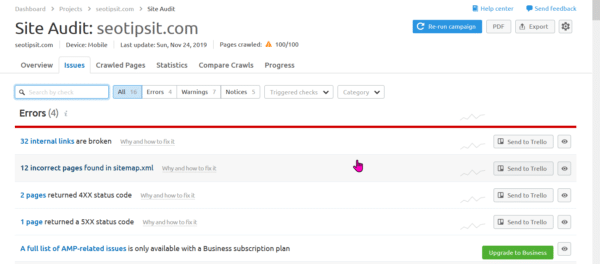Site Audit in 2020 is an important part of on-site optimization. SEMrush provides easy way to check your site health with easy tools. Find the common issues boggling your site and fix the important ones.
[wps_note size=”17″ background=”#fae588″ color=”#333333″ radius=”3″] Health score is an important feature of SEMrush tool. SEO of your site can be improved by finding pages with errors, warnings and issues. Fix hreflang mistakes so that different language versions of your site are visible in search engines. [/wps_note]
You can find the most serious issues that are causing a “negative mark” on your technical SEO. Fix them and re-audit your site. If your errors, warnings and notices are fixed, they will be available under “comparable” report.
Several other features like security, duplicate content, 404, 503 error codes, broken links, mixed content issues, missing h1 titles, sitemap errors, blocked external resources and many other technical factors can be checked using this tool.
In this post we are going to see the SEMrush site audit tool features and its influence in correcting the mistakes of your site.
Related Topics:
- SEMrush Review – What you can do with Display Advertising
- Keyword Research Using SEMrush – 3 Intuitive Ways To Improve On-Page SEO
- Keyword Analysis using SEMrush, GA and GKP
SEMrush Site Audit settings
1. Domain and limit of pages
You can set the crawl scope which includes the subdomains. The number of checked pages per audit also can be limited. The crawl source like website, sitemaps on site, enter sitemap url, URLs from file can be set.
2. Crawler settings (optional)
The user agent for crawling the site like – SEMrushBot-Desktop, SEMrushBot-Mobile, GoogleBot-Desktop, GoogleBot-Mobile can be set. The crawl delay settings which include minimum delay between pages, or set in robots.txt, 1 URL per 2secs can also be set here.
3. Allow/disallow URLs (optional)
You can allow certain pages or folders to be crawled. You can skip subfolders of the domain if you like.
4. Remove URL parameters (optional)
Certail urls have parameters like /page/ or /tag/ which can be removed from the audit. If you have included any parameters in Google Search Console, then you can add them here.
5. Bypass website restrictions (optional)
You can skip certain site restrictions like bypass disallow in robots.txt and by robots met tag can be done here. Even though you might not have allowed crawling in robots.txt, that restriction will be bypassed here.
6. Schedule (optional)
You can also set the audit schedule like a week, day, and once. This will let the SEMrush system audit your site on a specific day of every week.
SEMrush Site Audit Tool – Advantages
[wps_lists icon=”check” icon_color=”#81d742″]
- Tree of Site Structure graph
- Correct broken image alt attributes.
- Fix Duplicate content issues
- Fix JS and CSS file errors
- Validate Sitemap and Robots.txt file
- Issues with HrefLang attributes and fix them
- Find Broken Canonical URLs and fix them.
- Number of pageviews generated for a particular URL over a month’s period.
- Number of clicks required to reach a particular page from home pages.
- Total number of issues detected on a page which includes errors, warnings and notices.
- Whether HTTP status code of 200 is returned or not.
- Amount of Text-HTML ratio and make adjustments.
- Find Encryption Errors and fix them.
- Number of HTTPS pages redirecting to HTTP pages.
[/wps_lists]
Some of the above stats can be got from free Google tools like Analytics and Search Console. But what if you want to do complete audit of your site regarding health, HTTPS, title tags, canonical urls, duplicate content etc, you need to analyze the site errors, warnings and fixes.
Site Audit
SEMrush will give the health score of your site after SITE AUDIT.
[wps_note size=”17″ background=”#fae588″ color=”#333333″ radius=”3″]This score is based on the amount of issues (for eg the number of internal links that contain nofollow attribute, number of posts having low text-HTML ratio, how many pages having more text within the title tags etc) found to the number of checks performed based on SEMrush rules.[/wps_note]
You will also know the number of pages with issues out the total number of crawled pages.
It will also show what is the percentage change in the health score from the previous audit done.
Out of the total crawled pages you can see pages which are –
- Healthy
- Broken
- Have issues
- Redirects
- Blocked
The Site Audit report shows the total number of errors, warnings, and notices. It also shows whether the crawler type is desktop or mobile. The last updated audit date and number of crawled pages can also be seen here.
Top issues of the site also can be seen in the site audit overview.
These include the number of pages showing
– 4XX status code
– 5XX status code
– number of internal links that are broken
Issues Report
This report will show errors, warnings and notices.
In the Guru plan, the error report shows –
- Number of internal links broken
- Incorrect pages found in sitemap.xml
- Pages that returned 4XX code and 5XX code
- Articles without any title tags
- Headings with duplicate title tags
- Posts that have duplicate content issues
- Pages that couldn’t be crawled
- DNS resolution issues
- Incorrect URL formats
- List of internal images that are broken
- Pages that have duplicate meta descriptions
- Any format errors in robots.txt file
- Format errors in sitemap.xml file
- Articles that have www resolve issue
- Pages that have no viewport tag
- Posts that have too large HTML size
- AMP pages that have no canonical tag
- Issues with hreflang values
- Hreflang conflicts with page source code
- Issues with incorrect hreflang links
- Problems with expiring or expired certificates
- URLs using old security protocol
- Articles having mixed content
- Issues with redirect chains and loops
- Broken canonical link errors and issues
- Pages that have multiple canonical URLs
- Articles that have a meta refresh tag
- Issues with broken internal JS and CSS files
- sitemap.xml files are too large
- pages that have slow load speed
The Business plan will show further issues like –
- full list of AMP related issues
A typical warning report will show –
- How many HTTPs pages lead to HTTP.
- Number of outgoing internal links that contain nofollow attribute
- Pages that have duplicate H1 and title tags
- Content that have too much text within the title tags
- Articles that have low text-HTML ratio
- Number of external links that are broken
- Pages that have low word count
- Number of external images that are broken
- Pages that don’t have enough text within title tags
- Titles that don’t have H1 heading
- Content that don’t have meta descriptions
- Pages that have too many on-page links
- Temporary redirects
- Images that don’t have alt attributes
- Pages that have too many parameters in the URLs
- HTML pages that contain frames
- Web Pages with flash
- Number of uncompressed pages
- Issues with unminified JS and CSS files
The Notices report will show –
- Resources that are formatted as page link
- URLs with a permanent redirect
- Outgoing external links that contain nofollow attribute
- Pages that are blocked from crawling
- Pages that have only one incoming internal link
- Subdomains that don’t support HSTS
- Issues with blocked external resources in robots.txt
- Issues with broken external JS and CSS files
- Pages that need more than 3 clicks to be reached
Crawled Pages
This will show the Internal LinkRank (ILR). It measures the link juice flow between your website’s pages using a 100 point scale. If a page is linked from high authority pages of your site, than the LinkRank will be high.
This can also be seen in the Search Console report. But it doesn’t give any score.
Statistics
The following are the features of this audit report.
- Markup
- Crawl Depth
- HTTP Status Code
- Canonicalization
- AMP Links
- Sitemap vs Crawled Pages
- Incoming Internal Links
- HrefLang Usage
Compare Crawls
In this report, you can see the difference between any two audit reports. It will indicate the fixed and new issues. The report shows that number of pages crawled, overall score, total issues, total errors, total warnings and total notices.
Errors
Typical errors like – 5xx, 4xx, duplicate content, duplicate title tags, DNS resolution issue, large HTML page size, missing canonical tags in AMP pages, non-secure pages, certificate expiration before and after the audit.
Warnings
Content that has warnings before and after the audit. These include broken external links, broken external images, long title element, missing meta description, missing ALT attributes, low word count, existence of sitemap.xml, JS and CSS errors etc.
Notices
Comparison of notices feature report can be done. Multiple h1 tags, pages blocked from crawling, URLs with no HSTS support, orphaned sitemap pages, blocked external resources in robots.txt, page crawl depth with more than 3 clicks, permanent redirects etc.
Progress
In this report, we can see the historical chart for audits. You can also create graphical chart based on pages crawled, total issues, total warnings, total errors, total notices, overall score. The legend of the chart can be based on different errors, warnings and notices.
Conclusion
The above reports are helpful to decide whether your site is SEO friendly or not. Once you fix the critical site errors, you can check the progress of your SEO audit. If your health score increases, it means that the changes you make have taken effect.
This is the first step in on-page optimization of your site. You still have to build links, write relevant content, improve domain and page rating, get conversions and clicks. SEMrush site audit tool will give you the loop holes of your blog. To optimize your site for search engine you need to track the progress of your changes.
This can be done by comparison with previous audits. If you have made any fixes, your site should show improvement in ranking and traffic. The main advantage with this site audit tool, is that you can see all the URL reports at one place.
Instead of dwelling into each page for different errors, you can get an overview of all the issues, warnings and necessary changes required. A broad picture of actionable items that needs to be updated, edited or changed can be seen at one place.
Finally, an in-depth audit of your site will give you clear understanding of the drawbacks. A good health score indicates that you have made the right changes to your site.




Hi! So comprehensive post. I finally got it! thanks a lot
Could you possibly can write the same post about other tools, SerpStat for example?
I’m trying to choose the right tool but it’s so tough to figure them all out
@Mark: Wonderful remark. I would love to do review for several SEO tools, but time is short, as I have a full-time job. Also each SEO tool has its own merits. I tried LTP, AHREFS, MOZ etc. and each one has its own strength and deficiencies. SERPSTAT was a freeware kind of tool previously and now it has a more brand image. If it has a free trial with all its features, Yes, I’m interested to do it.
First time visiting your website, I love it!